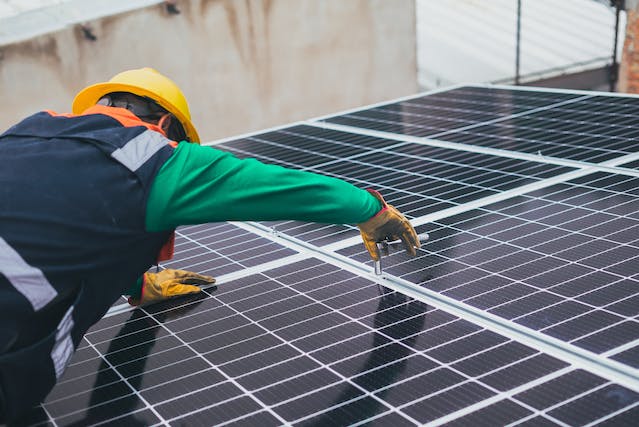According to SEIA, the average lifespan of a solar PV system is 20-30 years. What happens when it nears the end of its life? Materials expire, components stop working, and the system gives subtle signs that it’s time to throw it away. However, worn out solar panels can be challenging to dispose of after the material is spent. The good news is that solar panel recycling is being widely implemented to make the investment beneficial for the environment (and help users minimize their carbon footprint). Below is a detailed breakdown of the whole concept.
Why Solar PVs Deteriorate?
Like most tools, panels are prone to wear and tear that results from prolonged use. While they don’t contain moving components, the chemicals used in these panels can break down and expire after a certain period. Moreover, debris and storms can have a devastating impact on the panel. PVs in warmer regions may reach their end of life earlier since the hot temperatures reduce the efficiency of solar cells.
Panels bought a decade or two ago may still generate electricity, but the amount they generate won’t be at par with what they used to produce in the past. So, if a panel is meeting your household’s energy needs, you may not have to purchase a new one (for now), though it’s critical to understand what you should do with it once its lifespan comes to an end.
The Recycling Process
Generally, there are two key types of solar panels, and each of them requires a different approach to cycling. Whether you’re using a thin-film type or a silicon-based variant, both can be recycled using distinct industrial methods. While silicon-based panels are more common in this day and age, thin-film based panels do have their use in residential and commercial environment. Described below are processes through which both panels are recycled.
Recycling Silicone-Based Panels
Recycling silicone-based panels require users to disassemble the main product to separate glass and aluminum components. The majority of the glass can be reused, while cell frames can be remodeled using all external metal components. The rest of the materials can be put under 500°C (inside a thermal processing unit) to streamline the “binding” between the elements of the cell.
Because of the scorching heat, the encapsulating plastic is going to evaporate, leaving silicon cells behind for further processing. The supporting technology ensures the plastic isn’t wasted, but used as a heat source for additional thermal processing. Once the thermal treatment comes to an end, the hardware is manually detached to be reused or refined (most of it is reused). Wafers or silicon particles are engraved with the help of acid. Detached wafers are melted to be reused for producing new modules for the silicon, resulting in a high recycling rate for the silicon material.
Recycling Thin-Film Based Solar Panels
Thin-film based panels, in contrast, requires users to adopt a more drastic procedure. The main step involves placing the panel inside a shredder. Next, a hammermill is used to get the particles to 4-5mm in size (which is the size required for breaking the lamination that’s keeping the internal materials together and therefore can be removed). When it comes to the remaining parts, the substance is both liquid and solid material. A rotating screw is then utilized to separate both materials.
The screw’s main purpose is to keep the solid components rotating inside a “tube” under a container is filled with the liquid. Purity can then be achieved by taking the liquids through a dewatering and precipitation process. Additionally, the substance produced can also be taken through metal processing to detach the relevant semiconductor materials. However, this process depends on the main technology that was used while the panels were manufactured. With that said, most of the semiconductor elements can be reused. Moreover, matters contaminated with interlayer materials (which are light in mass) can be removed via a “vibrating surface.” Lastly, the material experiencing rinsing, after which the only thing left is pure glass. Pure glass elements are preserved to be reused in manufacturing.
Benefits of Solar Panel Recycling
The process has positive implications for both the economy and the environment. According to IRENA’s report from 2016, the recyclable components of expired solar modules will have a $15 billion worth in recoverable value by 2050. Also, recycling solar panels can help generate green job employment and create new industries. The need for this will become more and more obvious as heaps of commercial panels reach the end of their lives. Residential owners, too, will be looking to do something about the panels installed on their roof, and recycling is the perfect way to put them to good use.
Manufacturers offering the option also get to gain. For instance, they can leverage the rare elements that go into the design and building of solar PVs, such as crystalline silicon panels’ silver. These sort of elements can be preserved throughout decades for the production of future solar-based products. For certain technologies, like perovskites and organics (panels that utilize more toxic elements), recycling processes have not been created yet, but that may change in the near future.
Conclusion
Now that you know how solar panels are recycled, it’s time to talk to your vendor or retailer. Ask them if they offer this as an option, and try finding solar panel users who you could jointly cycle with. Thanks to continuous price drops, more and more companies and households are investing in solar technology. Therefore, even greater opportunities in the solar recycling area will emerge sooner or later.
